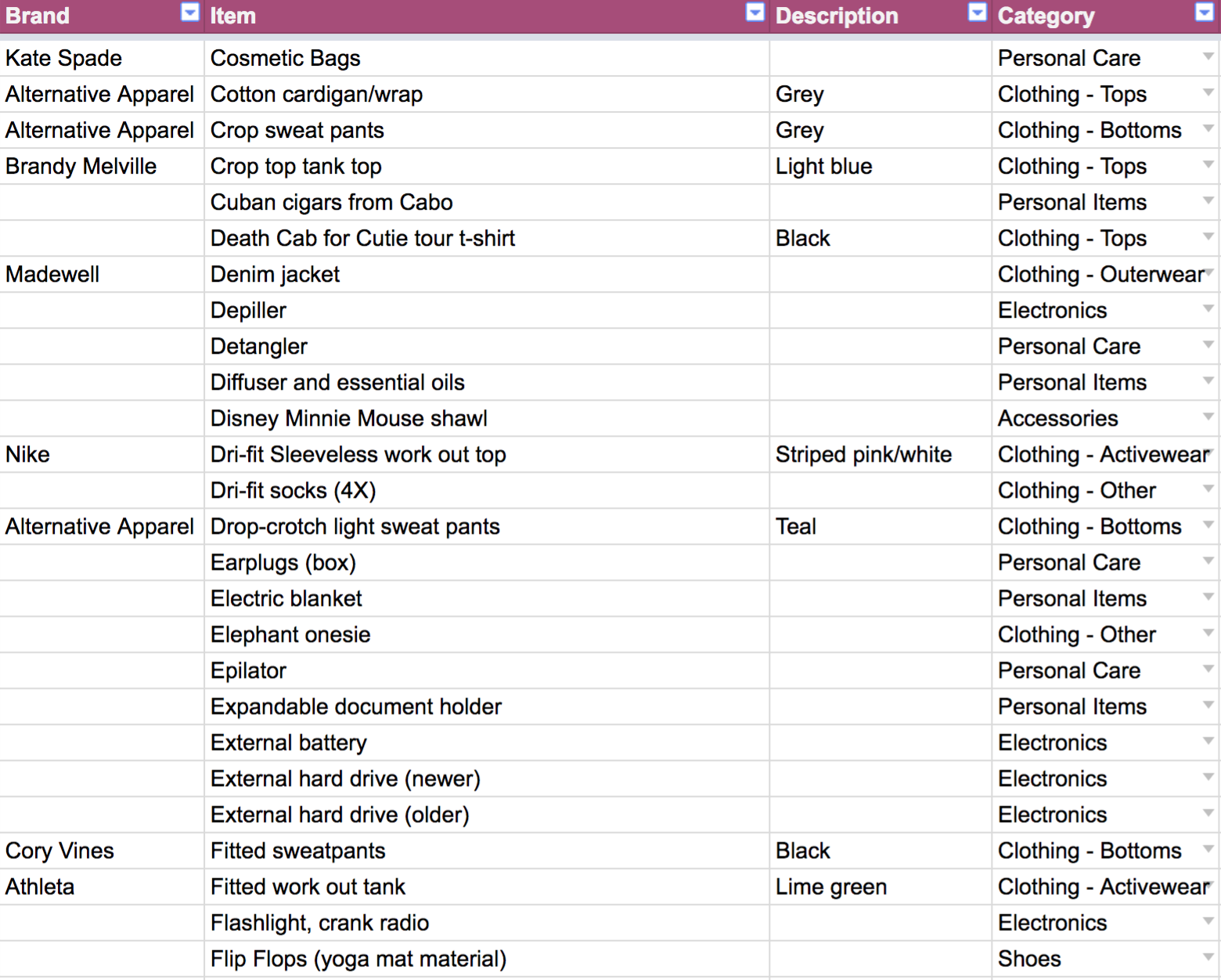How to move out of the country, pt 1
So you’ve decided you want to move out of the country? It may seem daunting especially if you have been in your current place for many years and have accumulated a lot of things and dependencies. Here’s a step-by-step guide of what I did, and hopefully this helps to get you going.
Get rid of everything you don’t need
Depending on how long you have been living in your current place, you may have accumulated an alarming amount of possessions. The more stuff we have, the more chained we feel to our current situation. It’s very important to start purging early. In fact, you don’t even need to have plans to move to do this. Maybe if you got rid of a lot of stuff that you own, you would feel more free and lightweight and the sense of mobility will naturally follow!
Step 1: Track what you own
When my S.O. moved from Boston to San Francisco last year, he had a spreadsheet of everything he owned. There were less than 100 rows! My mind was blown. So I decided to do the same thing shortly after I decided I would be moving. I sat down one Saturday afternoon and went through every nook and cranny in my room and diligently filled out a spreadsheet. I noted down the brand (if any) of the item, a basic name for the item itself, a description (usually the color, more if needed). It doesn’t need to be overly descriptive, just enough for you to know at a quick glance exactly what item it’s referring to.
 A sample of my spreadsheet. I even went as far as categorizing my items. I only did this because I wanted to know how much of each category I owned #gottahavethedata
A sample of my spreadsheet. I even went as far as categorizing my items. I only did this because I wanted to know how much of each category I owned #gottahavethedataFor me, this was important to see how much stuff I had. And I felt like I had a lot– about 259 rows worth of stuff.
Step 2: Assign a fate
Next, I created a “Fate” column. I went through every single item and assigned one of the following fates if it came to me instantly. I left blank the ones I wasn’t sure of yet. There’s no need to rush this part.
Keep
Items in this category are things that I probably would consider my essentials and would follow me wherever I go around the world. They include my current wardrobe, toiletries, and personal items such as journals, my water bottle, and my kindle.
Donate
Items in this category are things that were probably useful to me at one point but no longer serve the same purpose. Examples are old water bottles, kitchenware, clothes I haven’t worn in a long time, and outdated electronics. Off to Goodwill they go!
Trash
Items in this category are things that I probably should have let go a long time ago as they have practically lost all their value. Examples include old make up and make up brushes, worn out shoes, and broken electronics.
Leave at home/storage
Items in this category are those I have sentimental value for, or probably believe it will come in handy sometime in the future. They are items I will be leaving at my parent’s home for storage. Examples include jewelry, books, winter clothing, and dresses.
Sell
These are items that I no longer need but still have a high enough market value that I wouldn’t donate it. I used Thredup to sell my clothes, and Craigslist/Nextdoor for other items such as car jumper cables, hue lights, and speakers.
Give away
These are items that I think would be useful to someone else. I usually have a friend in mind when I come across these. This is a great category because gift-giving is one of my love languages and I can think of no better way to show my appreciation to my supportive friends. Also, now they have a way of remembering me while I’m traveling!
This gave me a sense of what I was dealing with. After my first pass, I had only a small percentage of my items as ‘Keep’ or ‘Leave at home’. This was a great start and motivation for me to keep going.
Step 3: Rinse and repeat
Rest assured this isn’t something that gets done in one afternoon, one weekend, or even one week. Not even a month! I feel like I have been perpetually purging for months before my departure date.
Doing this also takes time. No doubt you will have emotional ties to your belongings, and it would be silly to expect someone to not be human about discarding their precious possessions. But the mindfulness of the stuff you own will help you figure out over time the real purpose of an item in your life.
For example, after my initial purge of clothing, I did the ‘reverse clothes hanger’ test. I reversed all my clothes hangers so that it non-intuitively hooks from behind. After I wear the item and I need to hang it up again, I allow myself to hang it the proper way. Over the course of 3-4 weeks, I notice what clothes I tend to wear more. After about a month, you will have some clothes hangers that never flipped back the right way. Now you have a clear signal of what to purge and what to keep.
Final thoughts
Remember that we are only human– we change our minds often! An item that you marked ‘donate’ might have you feeling otherwise the next week in the same way that an item you thought you wanted to keep suddenly doesn’t seem as appealing after a few days. I was very open to these changes; however, the important thing is that once an item was no longer in my possession, I marked its status column ‘done’, and set a filter to hide these rows. No need to keep these in mind anymore!
Also worth mentioning that over time, I have developed a mild obsession with purging. There is something very thrilling about donating or giving something away and I revel in the feeling of almost weightlessness post-purge. I definitely didn’t feel this way when I first started!
I’ve been telling people that moving out of the country has been a great way to ‘reset’. By only carrying forward with me what I know I need, it eliminates all the unnecessary excess from a previous time and allows me to factory reset to a fresh yet functioning mode.
Here was the final tally for me:
| Fate | Count | Percentage |
|---|---|---|
| Keep | 74 | 28.57% |
| Leave at home | 66 | 25.48% |
| Donate | 64 | 24.71% |
| Give away | 22 | 8.11% |
| Sell | 18 | 6.95% |
| Trash | 15 | 5.79% |
Book your one-way ticket out.
I booked my one-way ticket out of San Francisco for November 28 on September 9. That gives over 2.5 months to get everything in order which seemed like the perfect amount of time. It’s far out enough where you don’t have to deal with the emotions or the stress of limited time for another few weeks. It was the right amount of time for me for it all to sink in.
Booking your one-way ticket is definitely the forcing function. Once you have this one, it kicks everything off and gives all your preparation real meaning.
Get all your health checks
Depending on where you’re going, you may be leaving behind better health coverage where you currently are. Even though I am stuck with a shitty health insurance company in America, it provides me more comprehensive benefits than what a travel insurance would get me. So I made sure to get my dental cleaning, annual wellness exam, updated vision prescription, and vaccinations before I left. I also requested my full medical history from my primary care physician– note that this usually comes with a fee.
Audit and cancel your recurring payments
A service like Truebill might come in handy to show you what recurring payments you have to see what subscriptions you might need to cancel when you move away. It’s also good to note down when is the earliest (or latest) date you’ll allow yourself to cancel, depending on the varying policies.
For me, I had the following to cancel:
- Gym membership
- Health insurance
- Car insurance
- Renter’s insurance
- Cell phone plan
The only subscription I’m keeping is Spotify since that works worldwide!
Opt out of unwanted mail
Once I knew I was moving, I started to comb through my mail very carefully, noting down the promotional mails I would receive from various companies I had purchased orders from. I then would make sure to contact them and ask to opt out of the mailing service.
For most companies, the snail mail opt-out process was fairly painless– either a quick e-mail to customer support or filling out a form on their website. Others were a bit more troublesome– I had to call in to one company and ended up staying on the phone with them for 7 minutes including hold time. Doesn’t seem like a substantially long time but to opt-out of receiving promotional material, it feels like a long time.
I’ve also noticed that non-profits or local organizations tend to ignore my requests to opt-out. I used to donate money regularly to a local charitable organization, and they send me at least one piece of mail every month soliciting more donations. I’ve tried to e-mail and contact them various times, but to this day, I still receive correspondence from them.
This leads into my next step…
Look into a mail forwarding service
It’s important for me to set up a mail forwarding service since I don’t have any family in America and I don’t want to burden my friends with managing my mail while I’m gone. Mail forwarding services are basically where you can pay to have an address in America, and all incoming mail gets scanned and presented to you through their website. The exact details depend on the type of payment plan you get, but generally they charge by how many pieces of mail you get and how many pieces of mail you’d like them to open and scan for you.
I’m trying to stay within the cheapest tier of the service I’m signing up for, so part of that is lowering the amount of junk mail I receive.
Check my post here for more information and a deeper analysis between the different companies.
